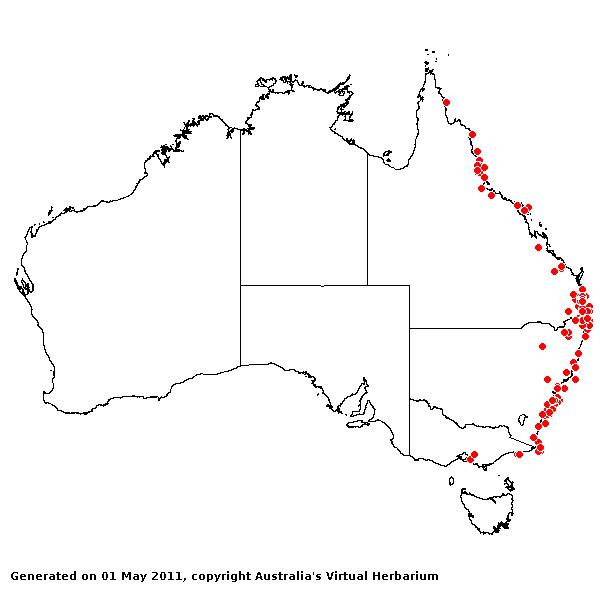Oplismenus imbecillis (R. Br.) Roem.
& Schult. Syst. Veg. 2: 487 (1817).
Classification.
(GPWG 2001) : Subfamily Panicoideae. Paniceae.
Basionym and/or
Replacement Name: Orthopogon
imbecillis R. Br., Prodr. 194 (1810).
Type of Basionym or
Protologue Information: Australia: New South Wales: Port Jackson, Brown
6133 (HT: BM; IT: E, LE) 'Sattelberg bei Finschhafen im Walde.'.
Key references
(books and floras): [1810]. R.Brown, Prodromus (194 as Orthopogon),
[1878] G.Bentham, Flora Australiensis 7 (492 as Oplismenus setarius),
[1969] E.E.Henty, Manual Grasses New Guinea (133 as O. hirtellus),
[2002] D.Sharp & B.K.Simon, AusGrass, Grasses of Australia (as O.
hirtellus), [2008] S.W.L.Jacobs, R.D.B.Walley & D.J.B.Wheeler, Grasses
of New South Wales (309).
Illustrations:
[1984] N.T.Burbidge. rev. S.W.L.Jacobs, Australian Grasses (189), [2008] S.W.L.Jacobs, R.D.B.Whalley
& D.J.B.Wheeler, Grasses of New South Wales, 4th edn (309).
Habit. Annual
or perennial. Culms prostrate, 5–100 cm tall. Mid-culm nodes pubescent. Ligule
a fringed membrane, a ciliate membrane, 0.4–1.1 mm long. Leaf-blades lanceolate
to ovate, 1–13 cm long, 4–20 mm wide. Leaf-blade surface scabrous, indumented.
Inflorescence.
Inflorescence compound, a panicle of racemes. Racemes 3–9, 0.5–3 cm long.
Central inflorescence axis 3–15 cm long.
Spikelets.
Spikelets sessile and pedicelled, 2 in the cluster. Fertile spikelets
2-flowered, the lower floret barren (rarely male), the upper fertile,
comprising 1 basal sterile florets, comprising 1 fertile floret(s), without
rachilla extension, lanceolate, laterally compressed, 2–4 mm long.
Glumes.
Glumes similar or dissimilar, thinner than fertile lemma. Lower glume ovate,
herbaceous, keeled, 1-keeled, 3–5 -nerved. Lower glume surface glabrous or
indumented. Lower glume apex awned. Upper glume ovate, 1.6–2.1 mm long,
herbaceous, keeled, 1-keeled, 5–7 -nerved. Upper glume surface glabrous or
indumented. Upper glume apex muticous or awned. Florets. Basal sterile
florets 1, barren, with palea or without significant palea. Lemma of lower
sterile floret 100 % of length of spikelet, membranous, 1-keeled, 7–11 -nerved,
mucronate.
Fertile lemma 2–2.5 mm
long, without keel, 7 -nerved. Palea without keels.
Continental
Distribution: Africa, Temperate Asia, Tropical Asia, Australasia, Pacific,
North America, and South America.
Australian
Distribution: Western Australia, Northern Territory, Queensland, New South
Wales, Victoria, Norfolk I, Lord Howe.
Western Australia:
Gardner. Northern Territory: Darwin & Gulf. Queensland: Cook,
Darling Downs, Moreton, North Kennedy, Wide Bay. New South Wales: North
Coast, Central Coast, South Coast, Northern Tablelands, Central-Western Slopes.
Victoria: East Gippsland, Gippsland Plain.
Notes.
An extremely variable tropical species in which Shultz (1981) recognized 11
subspecies. Tends to intergrade with O. compositus and O.
undulatifolius, however, most specimens can be identified with confidence.
The morphological relationship between O. hirtellus and O. aemulus
is even more obscure and the characters commonly used to distinguish these taxa
cannot be applied consistently.
In tropical heaths,
tropical and subtropical rain forests, tropical and subtropical wet sclerophyll
forests, temperate wet sclerophyll forests, dry sclerophyll forests, and
tropical and subtropical sub-humid woodlands. Flowers Jan.-July.






